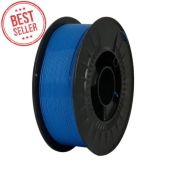We use cookies to make your experience better. Read more
15 August, 2024
What is ABS Filament - The Essential Guide to 3D Printing
Introduction to ABS Filament
Acrylonitrile butadiene styrene, commonly known as ABS, is one of the most widely used materials in 3D printing. As a thermoplastic polymer, ABS filament is favored for its durability, strength, and versatility. Since its patenting in 1948, ABS has found applications across numerous industries, including automotive, construction, and consumer goods. This article delves into the composition, properties, and uses of ABS filament, highlighting why it remains a top choice for 3D printing enthusiasts and professionals alike.
Composition and Properties of ABS Filament
ABS is composed of three primary monomers: acrylonitrile, styrene, and butadiene. Each of these monomers contributes unique properties to the final product:
- Acrylonitrile: Provides rigidity, strength, and chemical resistance.
- Styrene: Adds a smooth, shiny texture.
- Butadiene: Contributes toughness and flexibility, making ABS particularly resilient.
These characteristics make ABS filament machinable, durable, and capable of withstanding high temperatures. It’s also known for its excellent melt flow and resistance to strain and abrasion, making it an ideal material for producing strong and functional 3D printed parts.
At 3D Trček, we specialize in the production of high-quality ABS filaments that meet the demanding needs of our customers. Our ABS filament is designed to offer superior performance, whether you’re working on prototypes, end-use parts, or any other application requiring robust material properties.
ABS vs. Other Filaments
While ABS is a popular choice, it’s important to understand how it compares to other commonly used filaments like PLA and PETG. ABS is non-biodegradable and is typically used for parts that need to withstand stress and temperature variations. PLA, on the other hand, is made from biodegradable materials like corn starch and is often used for less demanding projects, such as display models.
PLA+ is an enhanced version of PLA, offering improved quality but with a narrower printing temperature range (200–230°C) compared to ABS (210–250°C). PETG, which contains modified glycol, offers good strength and better UV resistance than ABS, making it suitable for outdoor applications. However, ABS outperforms PETG in terms of heat resistance, making it the preferred choice for high-temperature environments.
Here’s a quick comparison of the properties:
| Property | ABS | PLA | PETG |
|---|---|---|---|
| Impact strength | 200-215 J/m | 26 J/m | 101 J/m |
| UV resistance | Average | Average | Better than ABS |
| Thermal conductivity | 0.17-0.23 W/mK | 0.111 W/mK | 0.21 W/mK |
| Tensile strength | 2.96-43 MPa | 59 MPa | 53 MPa |
| Flexural strength | 2400 MPa | 106 MPa | 70 MPa |
These comparisons highlight the strengths of ABS filament, particularly its durability and heat resistance, which are crucial for many 3D printing applications. At 3D Trček, we offer both standard ABS filaments and ABS Plus filaments that cater to a wide range of printing needs. Whether you need a material that can handle high-stress environments or one that provides a smooth finish, our filaments are designed to deliver.
Pros and Cons of ABS Filament
Pros:
- Mechanical Properties: ABS is known for its strength and durability, making it suitable for creating long-lasting parts.
- Affordability: Compared to other materials with similar properties, ABS is relatively inexpensive.
- Ease of Post-Processing: Acetone can be used to smooth ABS prints, removing layer lines and giving the finished product a polished look.
- High-Temperature Resistance: ABS can withstand relatively high temperatures, making it ideal for applications that require heat resistance.
Cons:
- Fumes: ABS emits volatile organic compounds (VOCs) during printing, which can be hazardous and require proper ventilation.
- Warping Issues: ABS is prone to warping if not printed under the right conditions, particularly if the layers cool unevenly.
- UV Sensitivity: Prolonged exposure to UV radiation can cause ABS to discolor and become brittle, limiting its use in outdoor environments.
3D Trček’s ABS filaments are crafted with precision to minimize these drawbacks. Our filaments are designed to offer consistent performance, reducing the risk of warping and ensuring high-quality prints every time.
Recommended Configuration Settings for ABS
To achieve optimal results when printing with ABS filament, it’s crucial to configure your 3D printer correctly. Here are some recommended settings:
| Printer Setting | Value |
|---|---|
| Extruder temperature | 230-250°C |
| Bed temperature | 95-110°C |
| Print speed | 30-60 mm/sec |
| Extruder fan speed | 0-30% |
| Retraction speed | 25 mm/sec |
| Retraction distance | 3-6 mm (Bowden), 0.5-0.8 mm (DD) |
| Layer height | 0.15-0.2 mm |
| Bed material | Glass with glue, PEI, etc. |
These settings are designed to maximize print quality and reduce common issues like warping. At 3D Trček, we understand the importance of reliable performance, which is why our ABS filaments are engineered to work seamlessly with a variety of 3D printer models.
Tips and Tricks for 3D Printing with ABS
Printing with ABS can be challenging, but with the right techniques, you can achieve excellent results:
- Stable Environment: Ensure your printer is in a location with a stable temperature. Avoid drafts and sudden temperature changes that can affect the printing process.
- Bed Preparation: Use glue on the printing bed to improve adhesion and prevent warping. A heated bed set to around 90–100°C works best.
- Slow Print Speed: Start with a print speed of 30 mm/s and gradually increase if necessary. This helps each layer cool properly and adhere to the next one.
- Proper Storage: Store ABS filament in an airtight container to prevent moisture absorption, which can affect print quality.
- Wall Thickness: While thin walls can save material, it’s advisable to keep walls at least 1.5mm thick for strength and durability.
Conclusion
ABS filament remains a staple in the world of 3D printing, offering a balance of strength, durability, and affordability that’s hard to beat. Whether you’re creating functional prototypes, end-use parts, or intricate designs, ABS provides the reliability and performance needed to bring your projects to life.
At 3D Trček, we take pride in producing high-quality ABS filaments that meet the demands of today’s 3D printing enthusiasts. With our extensive experience in thermoplastic processing and commitment to quality, you can trust our products to deliver outstanding results every time.
For more information about our ABS filaments and other 3D printing materials, visit our website here. Let us help you take your 3D printing projects to the next level!



Please complete your information below to login.
Anmelden
Neuen Account erstellen